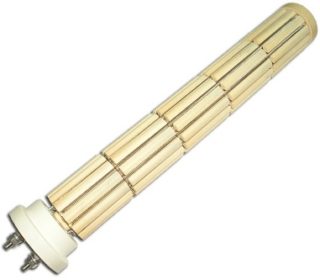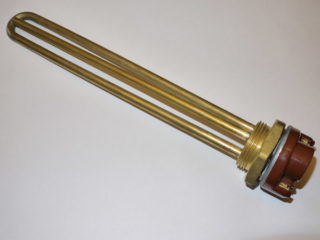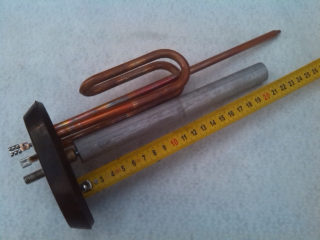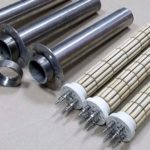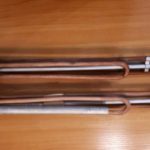The boiler is used to organize hot water supply in the house when centralized water supply is temporarily or permanently absent. The main working device is a heating element - a heat exchange element, a curved or straight metal tube. An electric current passes through the water heating heater, due to which the temperature of the tube rises, and with it the temperature of its environment.
Categories of heating elements by type of contact with liquid
Inside the heating element, a nichrome spiral is hermetically sealed for heating water, and the space between it and the outer walls is filled with quartz sand. The outer tube can be made of copper, carbon or stainless steel.
Open heating elements are in direct contact with water. Their main advantage is a high heating rate of the liquid and low cost, but there are significant disadvantages:
- limited service life;
- rapid formation of limescale;
- high power consumption;
- insecurity.
Closed do not come in contact with water. TEN is protected by a strong bulb. Its advantages:
- reduced likelihood of electrical short circuit;
- easy to repair and maintain;
- long serve - three times longer than open heating elements;
- consume significantly less electricity than open type heating elements.
There are two important disadvantages: high price and slow heating of water.
Criterias of choice
Choosing a heater for a boiler, it is necessary to build on the characteristics of a previously installed element.
Types of devices
In addition to the type of heating element in contact with the liquid, it is necessary to take into account a lot of other parameters:
- Way of fastening - nut or flange. The latter is cast or stamped. Flange mounting is typical for open type heating elements;
- Possibility of installing the anode - this element is designed to protect metal surfaces from corrosion and scale, due to which the overall service life of the boiler is increased. Gradually, the anode “melts”, so periodically you need to install a new one. If a hole for the anode is provided at the base of the heater, then a new heater with the same hole is needed.
- The shape depends on the type of storage capacity. The heating element may be straight or bent. Choose a heater similar to the previously installed one, taking into account not only the shape, but also the size, as well as the bending angle.
- Material of manufacture - the outer surface of the heater can be made of copper or stainless steel. It is important that the material of the tank and the heating element coincide, otherwise, due to the potential difference, the service life of the heating element and the tank itself will be reduced. A closed type copper heater can be located inside an enameled steel flask, in which case you can not worry about creating a galvanic pair.
Stainless steel heating elements are characterized by increased resistance to corrosion, and copper ones have greater thermal conductivity.
Features and amount of heated fluid
If the water is hard, a heater is required under the anode, which partially eliminates the problem of scale and will extend the life of the boiler. Power should correspond to the volume of heated fluid. It is recommended that you purchase a part of the same capacity as the failed one. Heater parameters are indicated in the technical data sheet of the device.
terms of Use
Power must match the wiring capabilities.But this is more related to the choice of a boiler, not a heater, since the old element is replaced with a new one of the same power. The power of the boiler as a whole also affects the heating rate of a given volume of water. If the heating element is low-power, for example, at 1000 W, and the capacity is at 80 or even 100 l, the water will be heated to maximum temperature for a very long time, several hours, so you need to turn on the boiler in advance. This power is optimal for small boilers, up to a maximum of 50 liters.
If you plan a large consumption of hot water, it is recommended to buy a model with two heating elements. They heat water faster. In economy mode, one element will work, and the second will be connected thanks to the thermostat, when it is necessary to heat a new portion of cold water.
Types of heating elements according to the principle of operation
Features of open and closed heating elements are clear from the name. The former are not protected from water, the latter are closed by a flask. In another way they are called wet and dry. The principle of their work should be considered in more detail.
Wet
Wet-type heating elements are tubular, directly contact with water and heat water with their surface. Their service life depends on the quality of the water, its hardness, and the percentage of salts. Due to the influence of these factors, the metal corrodes, and limescale forms on the surface. By installing a magnesium anode, the process can be slowed down because the element attracts salt. Also, glassy enamel is used to protect the water pipes.
Dry
A dry heater is a heater that is placed in a flask filled with a second layer of ceramic filling (the first layer fills the space between the nichrome spiral and the tube into which it is placed). The waterproof shell is made of magnesium silicate or steatite. Steatite quickly heats up and cools slowly, has increased strength and high thermal stability. The advantages of using a dry heater in a water heater are more than the minuses, and in particular, to replace such a heater, you do not need to drain the water from the boiler.
The heating element of a dry heater does not come in direct contact with water, but due to an increase in the thickness of the element, its thermal conductivity decreases and the water heats up more slowly at the same power. At the same time, the heat transfer area is increased, which allows some compensation for this drawback.
- Dry ten protective flask prevents contact with water
- Wet ten - there is an anode for protection
How to replace the heater in the boiler
The need to replace the heater occurs when it malfunctions. When it stops heating water, an electrical protective device is activated. The average service life is 4 years. Then it fails due to the increased hardness of the water. This event can be delayed if the boiler is serviced annually: descale the heater and the magnesium anode. This operation will increase the duration of operation and improve the quality of water, its heating rate. Before acquiring a new element, it is worth checking the condition of the old heater using a test lamp or multimeter. In the first case, a simple electrical circuit is assembled, including a lamp and a heater. If the light is on, the problem is not in it. In the second case, measure the resistance with a special device. A zero value indicates a heater malfunction.
The designs of different models of boilers have slight differences, but the principle of replacing the heater in a water heater is the same for all types of devices.
First, turn off the water supply, and the remaining liquid is drained from the boiler. The water heater must be de-energized by pulling the plug out of the socket. At the bottom of the boiler there is a cover that is fastened with screws. They need to be unscrewed with a screwdriver, and the lid will be removed.For safety reasons, before proceeding with the replacement of the heater in the boiler, you need to check the voltage at the terminals, for example, using an indicator screwdriver. Then disconnect the wires and unscrew the nuts that hold the heater in place. Replace the heater in the water heater, after checking that the contacts are dry. If an anode is installed in the boiler, replace it as well. Check the seal for leaks and screw the cover in place. After these manipulations, it is necessary to fill the boiler with cold water and bleed air out of it, opening the hot water tap. Only now can you plug it into the network.
Popular manufacturers
You should choose a heater from a trusted manufacturer. This is not the element to save on. The best firms include:
- Termex (Thermex). It produces boilers for almost 50 years. This manufacturer makes heating elements from copper and stainless steel. They are reliably protected, therefore they have a long service life. In the market, Termeks has established itself as a manufacturer of the largest volume boilers, so powerful electric heaters can be found in the assortment.
- Ariston. The heating elements from the Italian manufacturer are made of an alloy containing copper and are equipped with a nickel-chromium tube. The flange is made of brass, which increases the heat transfer. They are well protected from scale, easy to install. And at the same time they are relatively inexpensive. Ariston offers water heaters with a thread and a temperature regulator from 1.2 to 4.5 kW.
- Electrolux. You can choose the heater from this manufacturer for almost any model of heater. At the same time, they are guaranteed to last a long time, because they are especially resistant to scale and are not demanding on water quality. A water heater with a heater from Electrolux does not require frequent maintenance. Two closed heating heating elements are installed in some devices of this manufacturer, so it is possible to increase the heating rate of the liquid.
- Timberk. Another manufacturer that offers its products at an affordable price. In the assortment there are heating elements designed for boilers of 80 or more liters of water. They are well protected against corrosion and other damaging factors.
- Also known is the company Atlantic. It produces a wide range of high-quality and reliable heating elements for boilers, including copper hot water heating elements, dry steatite and others, suitable for vertical and horizontal installation.
Each manufacturer produces electric heaters designed for installation in boilers of its own production. However, you can find universal heating TENy. They are less popular due to questionable quality, but their use is possible.
Without a heater, boiler operation is impossible. This is the most important element that is selected taking into account the volume of the water heater, the characteristics of water consumption. Be sure to take into account which heating element was installed in the boiler earlier. It is advisable to choose exactly the same or as close as possible to the characteristics. You can replace the defective part yourself.
